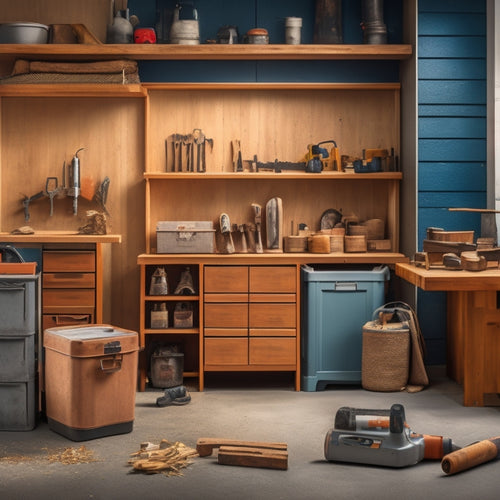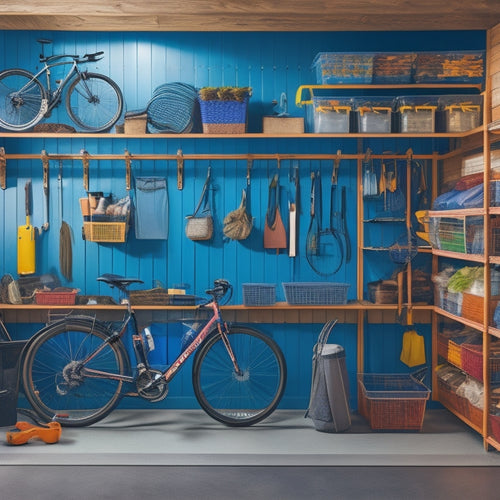
Maximize Your Garage Space for Business Success
Share
You're taking the first step towards unleashing your garage's full potential. Start by evaluating your space, identifying what's occupying your garage, and determining what needs storage. Purge unnecessary items, categorize similar ones, and assign a home for each. Make the most of your vertical space by installing shelves, using stackable bins, and utilizing overhead storage racks. Designate zones for specific tasks, like a workspace for projects or a maintenance station for vehicle upkeep. By implementing these strategies, you'll be well on your way to creating a garage that fuels your business success - and there's even more to explore to take your space to the next level.
Key Takeaways
• Assess garage space needs by identifying occupied areas, wasted space, and item sizes to plan an efficient layout design.
• Purge and declutter the garage by sorting items into keep, donate/sell, and discard piles to focus on essential items for business success.
• Categorize and group items by frequency of use, utilizing container organization and designating specific areas for each category.
• Assign homes for items within their categories, implementing storage solutions and labeling containers for quick identification and increased productivity.
• Utilize vertical storage space by optimizing shelf space and maximizing ceiling height with adjustable shelves, stackable bins, and overhead storage racks.
Assessing Your Garage Space Needs
Take stock of your garage's current state by walking in and making a mental note of what you see, including the items you need to store, the spaces that are already occupied, and the areas that are wasted or underutilized. This assessment is pivotal in determining your garage's space utilization and identifying areas for improvement.
As you observe your garage, think about the storage solutions you need to implement to maximize your space. Consider the types of items you need to store, their sizes, and how often you use them.
Next, conduct an inventory assessment to identify what you have, what you need, and what you can get rid of. This will help you determine the most efficient layout design for your garage. Think about the flow of traffic, the locations of frequently used items, and the areas that require the most storage.
Purge and Declutter Unnecessary Items
With your garage space needs assessed, you're now ready to tackle the often-daunting task of purging and decluttering unnecessary items that are hindering your space's full potential.
It's time to get ruthless – sort items into three piles: keep, donate/sell, and discard. Be honest with yourself, if you haven't used it in the past year, it's likely you won't miss it. Consider hosting a garage sale or organizing a donation drive to give back to your community while making some extra cash. This won't only free up space but also help you stay focused on what's truly essential for your business.
If you're feeling overwhelmed, consider hiring a professional organizer to guide you through the process. Alternatively, take the DIY organization route and break down the task into smaller, manageable chunks. Set a timer for 30 minutes and tackle one area at a time.
Categorize and Group Similar Items
Now that you've purged your garage of unnecessary items, categorize and group similar items together, such as tools, sports equipment, or storage bins, to create a sense of order and make the most of your newly freed-up space. This step will help you visualize how you can best utilize your garage for business success.
To categorize and group similar items, follow these steps:
-
Color code your categories using labels or stickers to distinguish between groups.
-
Identify the frequency of use for each item and group them accordingly.
-
Use container organization to store small items, such as bins or baskets, to keep them out of the way but still accessible.
- Designate a specific area for each category, ensuring that similar items are stored together.
Assign a Home for Each Item
Once you've grouped similar items together, assign a specific home for each item within its designated category, guaranteeing everything has a precise place to return to when not in use. This step is pivotal in maintaining organization and efficiency in your garage space.
By doing so, you'll avoid clutter and reduce the time spent searching for misplaced items.
Implement storage solutions that cater to each item's needs. For instance, install hooks for hanging tools, and use bins and baskets to store smaller items. Label each storage container to ensure easy identification.
This won't only save you time but also increase your productivity. With a designated home for each item, you'll be more inclined to put things back in their place, maintaining a sense of organization and structure.
Utilize Vertical Storage Space
Now that you've assigned a home for each item, it's time to make the most of your garage's vertical storage space. You'll want to optimize your shelf space by using stackable bins and baskets, and maximize your ceiling height by installing overhead storage racks.
Optimize Shelf Space
By installing shelves that go all the way up to the ceiling, you can effectively triple your storage capacity and make the most of your garage's vertical space. This is especially important if you're running a business from your garage, as you'll need to maximize every inch of space to stay organized and efficient.
To optimize your shelf space, consider the following space-saving solutions:
-
Install adjustable shelves to accommodate items of varying sizes.
-
Use stackable bins and containers to store small items like nuts, bolts, and screws.
-
Invest in DIY shelving or custom racks that are specifically designed for your garage's unique layout and storage needs.
- Label each shelf and bin so you can quickly find what you need, saving you time and frustration.
Maximize Ceiling Height
You can further capitalize on your garage's vertical space by utilizing the ceiling height to store less frequently used items, freeing up floor and shelf space for more immediate needs. This is where creative storage solutions come into play. Consider installing overhead storage racks or hooks to hang items like bikes, kayaks, or infrequently used tools. This won't only declutter your garage but also keep these items organized and easily accessible.
When designing your garage layout, incorporate space-saving techniques to maximize your ceiling height. For instance, you can install sliding attic storage units or overhead bins to store seasonal decorations, out-of-season clothing, or other items that don't require frequent access. These storage solutions will help you make the most of your garage's vertical space, keeping your floor and shelves clear for more pressing business needs.
Implement a Labeling System
Now that you've optimized your garage's vertical storage, it's time to implement a labeling system that'll help you quickly find what you need.
To get started, take stock of your storage needs and categorize your items into groups, such as 'seasonal decorations' or 'toolkit essentials'.
Identify Storage Needs
As you step into your garage, take stock of the items scattered around, and categorize them into groups that make sense to you, like tools, sports equipment, and seasonal decorations. This is the first step in identifying your storage needs and implementing effective inventory management. You'll be surprised at how much space you can free up by grouping similar items together.
To get started, consider the following:
-
Frequency of use: Identify items you use daily, weekly, or seasonally to determine the most accessible storage locations.
-
Item size and shape: Store large or bulky items in corners or against walls to maximize floor space.
-
Seasonal storage: Designate areas for seasonal decorations, winter clothing, or other items that only come out at specific times of the year.
- Frequently accessed items: Place often-used items in easy-to-reach locations to save time and increase productivity.
Organize by Category
Categorize your items into distinct groups, and then assign a home for each category, ensuring everything has a designated place and is easily identifiable. This sorting strategy will help you maintain an efficient arrangement, making it easier to find what you need when you need it.
Start by grouping similar items together, such as tools, equipment, and supplies. Then, assign a specific area or bin to each category, making sure it's easily accessible and visible.
Use a category classification system to label each group, such as 'Electrical Tools' or 'Painting Supplies'. This will help you quickly identify what's inside each bin or area, saving you time and effort.
As you organize, keep space optimization in mind, making the most of your garage's vertical and horizontal space. By implementing this labeling system, you'll be able to find what you need quickly, reduce clutter, and increase productivity.
With a well-organized garage, you'll be better equipped to serve your customers and grow your business.
Designate Zones for Specific Tasks
To optimize your garage's functionality, create designated zones for specific tasks. This includes a workspace for projects, a storage area for seasonal decorations, and a maintenance station for your vehicles. By doing so, you'll boost task efficiency and maximize space utilization. This approach helps you stay focused on the task at hand, reduces clutter, and saves time searching for misplaced items.
Here are four key zones to contemplate:
-
Workspace: Set up a dedicated area for projects, equipped with necessary tools and materials.
-
Storage: Designate a zone for storing seasonal decorations, out-of-season clothing, and other items that are only used occasionally.
-
Maintenance: Create a station for vehicle maintenance, with easy access to cleaning supplies, oils, and other essentials.
- Launch Pad: Establish a zone near the garage door for daily essentials, such as backpacks, lunchboxes, and sports equipment.
Maintain Your Organized Garage
You'll need to establish habits and routines to sustain your newly organized garage, guaranteeing it remains clutter-free and functional over time. Set aside time each week to tidy up and put away tools and equipment after use. This will prevent clutter from accumulating and keep your garage layout optimized.
Implement a 'one in, one out' policy to uphold your storage solutions. Whenever you acquire new items, get rid of old or unnecessary ones to prevent overcrowding. Label and categorize your storage bins and shelves to secure easy access and visibility.
Regularly inspect your garage's inventory and remove anything that's no longer serving a purpose. This will help you stay focused on your business goals and avoid wasting resources on unnecessary items.
Frequently Asked Questions
Can I Convert My Garage Into a Legitimate Business Workspace Legally?
You'll need to check your local zoning regulations to verify you can legally convert your garage into a workspace for your home-based business, obtaining necessary permits and licenses to operate smoothly.
How Do I Deal With Business Inventory That's Sensitive to Temperature?
"Your temperature-sensitive inventory is a ticking time bomb, but don't sweat it! You'll need to invest in climate-controlled storage solutions, like refrigerated units or temperature-regulated shelving, to keep your products safe and intact."
Can I Install Plumbing and Electricity in My Garage Workspace?
You can install plumbing and electricity in your garage workspace, but make sure you follow safety regulations and design your workspace with functionality in mind, considering plumbing options and electrical setup for best efficiency.
Are There Any Tax Benefits to Using My Garage as a Business Space?
You'll want to explore tax benefits for using your garage as a business space, considering home office deductions and potential zoning law impacts, to optimize your financial gains while serving your clients.
Do I Need Special Permits to Operate a Business From My Garage?
You'll need to check local regulations for home-based businesses, as zoning laws vary. Confirm you comply with permits and licenses required for operating a garage business, avoiding fines and legal issues down the line.
Related Posts
-

Small Storage Bins to Maximize Shelf Space
When maximizing shelf space, you want to make the most of every inch. Small storage bins are the answer, but choosing...
-

Tool Storage Chests for a More Organized Workspace
You're looking to enhance productivity and reduce stress in your workspace by getting your tools organized, and that'...
-

Garage Wall Storage Ideas to Boost Productivity
You can enhance your garage's productivity by capitalizing on your ceiling height with overhead racks, storing bulky ...


